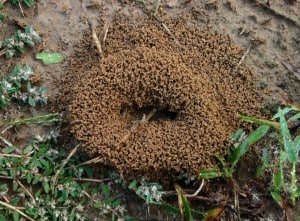Controlling Fire Ants This Spring
Spring weather has been known to increase the number of fire ant hills in the state of Texas. As frustrating as fire ants are, and no matter how much we would all love to kick away every fire ant pile that we see, scattering their mound will not eliminate the problem. Doing so may also increase your chances of being bitten, which nobody will enjoy. For those who have been bitten by a fire ant, or many in most cases of ant attack, you know the pain and discomfort that is associated with a fire ant bite. For those who have yet to be bitten, take this warning and avoid them if you can.

If you have noticed a fire ant mound popping up in your lawn, it is best to take care of it immediately. Fire ants, like many species of ants, prefer to live in dry, light soil that they can easily bring to the surface, to create and build-up their “ant hill”. These tiny pests can bring up a significant amount of dirt, which is why some methods of removal can kill the surrounding grass.
Fire ants are some of the most annoying pests to plague Texas lawns, and they can be difficult to remove if not done correctly. There are many myths on how to remove a fire ant infestation, but many of them are unsuccessful or can kill the surrounding patch of lawn. So which methods are the best for removing an ant hill and preserving your beautiful lawn?
Methods of Removal
Bucketing
Bucketing is the most simple way to remove an ant mound from your lawn, but there is a high risk of being bitten while completing this process. Bucketing requires the person to set out several buckets and rapidly dig up the ant mound, spreading out the mound across the different buckets. After this is done, it is best to sprinkle cornstarch over the top of the buckets, to try and keep the ants from coming out of the mound. You can choose to take these buckets to another, safe site or drown the ants with hot water.
The best time to bucket an ant hill, during the spring, is during the mid-afternoon. At this time, most of the ants will be inside of the mound, out of sight. It is very important to take extra precautions when completing the bucketing method, such as tucking your pants into your socks and shoes if possible. Since you are directly disturbing the ant pile, they will go into attack mode, and your legs may be at risk of being bitten.
Insecticides
There are certain insecticides that are made specially for eradicating certain ant populations, fire ants included. These insecticides are very effective, but some do not like using insecticides for gardening reasons. If this is the case for you and your lawn, bucketing may be the better option for you.
The Hot Water Method
One of the most effective ways to kill a fire ant pile is to dump hot or boiling water over the ant mound. However, it is NOT recommended that you do this. This method is widely used, but it also kills grass in the surrounding area, which is something that no one wants. Fire ants may be pests, but it is not worth it to put your lawn’s health at risk for removal. The two above methods are more effective in preserving your lawn while killing off the unwanted fire ant infestation.
If you have any questions regarding lawn care or purchasing sod, please contact the Grass Outlet today!





